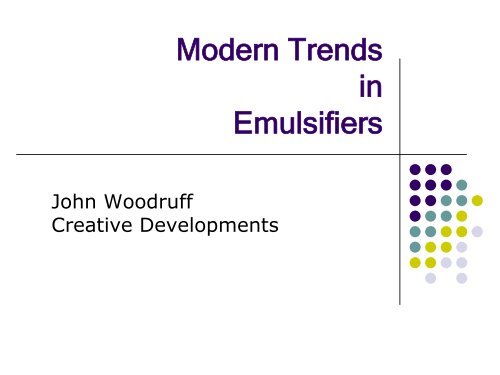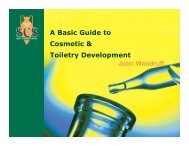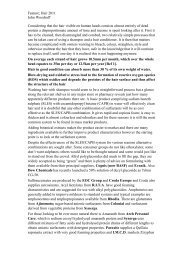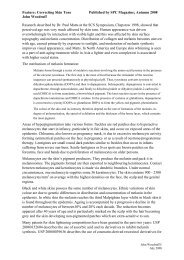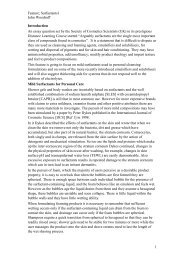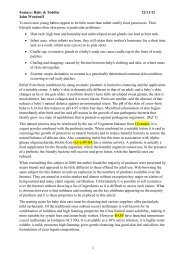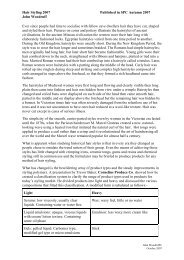Trends in Emulsifiers.pdf - Creative Developments
Trends in Emulsifiers.pdf - Creative Developments
Trends in Emulsifiers.pdf - Creative Developments
Create successful ePaper yourself
Turn your PDF publications into a flip-book with our unique Google optimized e-Paper software.
Modern <strong>Trends</strong><br />
<strong>in</strong><br />
<strong>Emulsifiers</strong><br />
John Woodruff<br />
<strong>Creative</strong> <strong>Developments</strong>
Modern trends <strong>in</strong> emulsifiers<br />
• Emulsions are a fundamental product form for<br />
many cosmetic categories and these are made<br />
possible by careful selection of the optimum<br />
emulsifier system.<br />
• Cosmetic science has progressed a long way from<br />
the early beeswax-borax and triethanolam<strong>in</strong>estearate<br />
comb<strong>in</strong>ations and there is now a trend<br />
towards those that form liquid crystal structures<br />
and emulsifiers that are acceptable when mak<strong>in</strong>g<br />
certified natural cosmetics.<br />
• This presentation gives a brief <strong>in</strong>troduction to<br />
emulsifier types then explores many of the more<br />
recent <strong>in</strong>troductions that satisfy today’s demands<br />
for stable emulsions with particular properties.<br />
www.creative-developments.co.uk 2
What makes an emulsion?<br />
Oils<br />
Moisturisers<br />
& special<br />
additives<br />
<strong>Emulsifiers</strong><br />
Water &<br />
water-soluble<br />
<strong>in</strong>gredients<br />
Rheology<br />
Modifiers<br />
Perfume<br />
materials<br />
Preservatives<br />
www.creative-developments.co.uk 3
Modern trends <strong>in</strong> emulsifiers<br />
• Keywords: Emulsions, emulsifiers, liquid crystals, natural<br />
cosmetics, phase <strong>in</strong>version technology (PIT)<br />
• Learn<strong>in</strong>g outcomes:<br />
• Chemical classes of emulsifiers<br />
• Liquid crystal structures<br />
• Natural emulsifiers<br />
• Phase <strong>in</strong>version technology<br />
• Emulsification of silicone compounds<br />
• Multiple emulsions<br />
www.creative-developments.co.uk 4
<strong>Emulsifiers</strong><br />
• <strong>Emulsifiers</strong> are employed <strong>in</strong> cosmetics to prepare<br />
emulsions.<br />
• The efficacy of emulsify<strong>in</strong>g agents depends on<br />
their ability to reduce surface tension, to form<br />
complex films on the surface of emulsified<br />
droplets, and to create a repulsive barrier on<br />
emulsified droplets to prevent their coalescence.<br />
www.creative-developments.co.uk 5
Some simple def<strong>in</strong>itions<br />
• An emulsion is a two-phase system. The pr<strong>in</strong>cipal<br />
components are an oil phase and an aqueous<br />
(water) phase.<br />
• The aqueous phase is water plus any comb<strong>in</strong>ation<br />
of materials which are polar and dissolve, at least<br />
to some extent, <strong>in</strong> water.<br />
• The oil phase comprises one or more oily<br />
materials, or other <strong>in</strong>gredients which are nonpolar<br />
and exhibit at least some solubility <strong>in</strong> oily<br />
materials.<br />
www.creative-developments.co.uk 6
Some simple def<strong>in</strong>itions<br />
• Oil-<strong>in</strong>-water (o/w): oil droplets dispersed <strong>in</strong><br />
water; the oil is referred to as the <strong>in</strong>ternal or<br />
dispersed phase and the water as the external or<br />
cont<strong>in</strong>uous phase.<br />
• Water-<strong>in</strong>-oil emulsion (w/o): water droplets are<br />
dispersed <strong>in</strong> oil; the water is the <strong>in</strong>ternal or<br />
dispersed phase and the oil the external or<br />
cont<strong>in</strong>uous phase.<br />
• Mixed emulsions are w/o/w or o/w/o<br />
www.creative-developments.co.uk 7
<strong>Trends</strong> <strong>in</strong> emulsifiers<br />
• Despite the 100s of emulsifiers available a quick<br />
look at <strong>in</strong>gredient labell<strong>in</strong>g will reveal that the<br />
numbers <strong>in</strong> use are relatively small.<br />
• However there are trends towards systems that<br />
form liquid crystals and those that have natural<br />
certification or are allowed <strong>in</strong> products claim<strong>in</strong>g<br />
natural or organic certification.<br />
www.creative-developments.co.uk 8
<strong>Trends</strong> <strong>in</strong> emulsifiers<br />
• The first cosmetic emulsion is credited to Roman times<br />
when Galen made one us<strong>in</strong>g beeswax, borax and rose<br />
water. By the 19 th Century cosmetic creams were be<strong>in</strong>g<br />
produced utilis<strong>in</strong>g fatty acid soaps, lanol<strong>in</strong> alcohols and<br />
sodium lauryl sulphate.<br />
• The first commercial stable w/o emulsion was Nivea cream,<br />
launched by Beiersdorf around 1910. Lanol<strong>in</strong> was the<br />
emulsifier and the formulation of Nivea cream has barely<br />
changed over the years.<br />
• Sorbitan esters and their ethoxylated counterparts were<br />
<strong>in</strong>troduced <strong>in</strong> about 1940 and the HLB system gave a<br />
scientific basis for emulsifier selection.<br />
www.creative-developments.co.uk 9
<strong>Trends</strong> <strong>in</strong> emulsifiers<br />
• By the beg<strong>in</strong>n<strong>in</strong>g of the 21 st century over 1800<br />
emulsifiers were listed <strong>in</strong> the CTFA Dictionary<br />
• These were broken down <strong>in</strong>to 17 chemical<br />
classes, not all of which would be considered<br />
suitable for prepar<strong>in</strong>g sk<strong>in</strong> care emulsions<br />
• In fact the majority of emulsifiers belong to only<br />
10 chemical groups<br />
www.creative-developments.co.uk 10
Chemical classes of emulsifiers<br />
• Anionic surfactants<br />
• Fatty acid soaps<br />
• Alkyl sulphates<br />
• Alkoxylated carboxylic<br />
acids<br />
• Phosphorous<br />
compounds<br />
• Cationic surfactants<br />
• Quaternary compounds<br />
• Amphoterics<br />
• Beta<strong>in</strong>es<br />
• Non-ionic surfactants<br />
• Sorbitan esters and<br />
ethoxylated esters<br />
• Glucosides<br />
• Transesters<br />
• Glyceryl esters<br />
• Others<br />
www.creative-developments.co.uk 11
Anionic surfactants<br />
• Fatty acid soaps<br />
• Triethanolam<strong>in</strong>e stearate<br />
• Alkyl sulphates<br />
• Sodium lauryl sulfate<br />
• Alkoxylated carboxylic acids<br />
• Laureth-5 carboxylic acid<br />
• Phosphate esters - alkyl phosphates and alkyl<br />
ether phosphates<br />
• Stearyl phosphate<br />
• Potassium cetyl phosphate<br />
• Lecith<strong>in</strong> is a naturally occurr<strong>in</strong>g phosphoric acid ester<br />
www.creative-developments.co.uk 12
Cationic surfactants<br />
• Quaternary ammonium compounds (quats) may be used to<br />
prepare o/w emulsions. More commonly used for hair<br />
condition<strong>in</strong>g e.g.<br />
• Behentrimonium methosulfate<br />
• Distearyldimonium chloride<br />
• Palmitamidopropyltrimonium chloride<br />
• Myristamidopropyl PG-dimonium chloride phosphate<br />
• Cetearyl alcohol is frequently used to thicken and<br />
stabilise cationic emulsions<br />
www.creative-developments.co.uk 13
Amphoteric surfactants<br />
• Alkyl beta<strong>in</strong>es<br />
• Alkylamido beta<strong>in</strong>es<br />
• Alkyl am<strong>in</strong>o propionates<br />
• No obvious emulsifiers found<br />
www.creative-developments.co.uk 14
Non-ionic Surfactants<br />
• Alkoxylated alcohols<br />
• Glycereth-n cocoate etc.<br />
• Fatty acid ethoxylates and glycol esters<br />
• C18-36 glycol ester etc.<br />
• Fatty alcohol ethoxylates<br />
• PEG-40 hydrogenated castor oil etc.<br />
• Ethoxylated carboxylic acids<br />
• PEG-12 laurate / stearate etc.<br />
• Glyceryl fatty acid esters<br />
• Glyceryl stearate etc.<br />
• Polyglyceryl-4 isostearate<br />
www.creative-developments.co.uk 15
Non-ionic surfactants<br />
Sorbitan esters and their ethoxylates<br />
• Sorbitan derivatives are the ethers and/or esters<br />
of sorbitan. Esterification with a fatty acid<br />
derivative yields the ester<br />
• e.g., Sorbitan oleate<br />
• Further acylation yields di- and other esters<br />
• e.g., Sorbitan sesquistearate<br />
Sorbitan esters are water <strong>in</strong>soluble, they have a low HLB<br />
value and form w/o emulsions and are often used <strong>in</strong><br />
conjunction with their ethoxylated equivalents<br />
www.creative-developments.co.uk 16
Sorbitan derivatives<br />
Ethoxylation of sorbitan results <strong>in</strong> a<br />
polyalkoxylated derivative which still possesses<br />
four hydroxyl groups and esterification provides<br />
esters which <strong>in</strong>clude polysorbates<br />
• e.g. Polysorbate 20<br />
• e.g. PEG-5 Sorbitan isostearate<br />
Polysorbates are water soluble. They have high<br />
HLB values and form o/w emulsions<br />
www.creative-developments.co.uk 17
Sorbitans and the HLB System<br />
• The Hydrophile-Lipophile Balance or HLB system was<br />
conceived by W C Griff<strong>in</strong> <strong>in</strong> the late 1940s and was<br />
particularly applicable to sorbitan esters and their<br />
ethoxylated derivatives.<br />
• It is based on an arbitrary scale of 0 – 20 and describes<br />
the relative simultaneous attraction of an emulsifier for<br />
water and oil.<br />
• If the surfactant is 100% oil soluble, its value on the HLB<br />
scale will be 0. When the surfactant is 100% water soluble,<br />
its HLB value will be 20.<br />
www.creative-developments.co.uk 18
HLB System<br />
HLB number of surfactant and type of emulsion<br />
formed<br />
• < 3 none<br />
• 3 – 8 water-<strong>in</strong>-oil (W/O)<br />
• 8 – 15 oil-<strong>in</strong>-water (O/W)<br />
• > 15 solubilisation<br />
www.creative-developments.co.uk 19
Transesters<br />
• Transesterification is catalysed by an acid or base, and can<br />
be carried out between a triglyceride (fats and oils) with an<br />
acid or alcohol to produce a complex equilibrium mixture of<br />
esters.<br />
• The product can undergo further treatment such as<br />
hydrogenation or alkoxylation to produce a wide variety of<br />
<strong>in</strong>gredients e.g.<br />
• Almond oil PEG-6 esters<br />
• Hydrogenated castor oil behenyl esters<br />
• Sweet almond oil polyglyceryl-6 esters<br />
www.creative-developments.co.uk 20
Other emulsifiers<br />
• Cetearyl glucoside<br />
• Sucrose esters<br />
• Sucrose cocoate / palmitate / stearate etc.<br />
• Polymers e.g.<br />
• Acrylates/C10-30 alkyl acrylate crosspolymers<br />
• Polyacrylates<br />
• Alkolylated dimethicones (AKA Dimethicone copolyols)<br />
• PEG/PPG-20/15 Dimethicone<br />
• Proprietary mixtures e.g.Versaflex V-150<br />
• Steareth-100, Steareth-2, Mannan, Xanthan Gum<br />
www.creative-developments.co.uk 21
Liquid crystal<br />
emulsifiers<br />
Liquid crystals comb<strong>in</strong>e the properties of both<br />
liquid and solid states; they have spatial<br />
orientation but rema<strong>in</strong> fluid
Liquid crystal emulsion<br />
www.creative-developments.co.uk 23
Liquid crystal emulsion<br />
www.creative-developments.co.uk 24
Liquid crystal emulsion<br />
• Benefits of liquid crystal formation<br />
Water, fatty acids,<br />
cholesterol,<br />
triglycerides and<br />
ceramides form the<br />
lamellar (layered) gellike<br />
lipid system of the<br />
horny layer.<br />
www.creative-developments.co.uk 25
Liquid crystal emulsifiers<br />
Examples<br />
• Cetearyl glucoside with cetearyl alcohol<br />
• Sorbitan olivate and cetearyl olivate<br />
• Sorbitan stearate with sorbityl laurate<br />
• Sorbitan stearate with sucrose cocoate<br />
• Polyglyceryl-3 methylglucose distearate<br />
• Potassium cetyl phosphate & hydrogenated palm glycerides<br />
• Lauryl glucoside & polyglyceryl-2<br />
dipolyhydroxystearate<br />
www.creative-developments.co.uk 26
Natural emulsifiers<br />
Some more natural than others
The natural trend<br />
• Beeswax<br />
• Forms w/o or o/w emulsions but odour difficult to<br />
disguise and emulsions very heavy<br />
• Lanol<strong>in</strong><br />
• Forms w/o emulsions but no longer a favoured <strong>in</strong>gredient<br />
• Lecith<strong>in</strong><br />
• Very limited to niche markets<br />
• Sapon<strong>in</strong>s<br />
• May be used as foam<strong>in</strong>g agents but have limited use as<br />
emulsifiers<br />
www.creative-developments.co.uk 28
Natural emulsifiers<br />
• The important parameter is that the system<br />
obta<strong>in</strong>s natural certification from a recognised<br />
body such as Ecocert<br />
www.creative-developments.co.uk 29
“Fairly Natural” emulsifiers<br />
• Natural oil esters and PEG-esters<br />
• Natural oil glyceryl and polyglyceryl esters<br />
• Natural oil PEG ethers & glycerides<br />
• Alkyl glucosides<br />
• Sucrose/glucose esters<br />
• <strong>in</strong> fact except for silicone-based emulsifiers virtually<br />
all others have a natural component <strong>in</strong> their<br />
molecule<br />
• ………………….but some are more natural than others!<br />
www.creative-developments.co.uk 30
Fairly “Natural” emulsifiers<br />
• Cetearyl glucoside<br />
• Cetyl olivate<br />
• Coco-glucoside<br />
• Sorbitan olivate<br />
• Lauryl lactyl lactate<br />
• Sodium stearate<br />
• Sunflower seed oil<br />
glyceride<br />
• etc<br />
• Natural oil polyglyceryl<br />
esters<br />
• Natural oil PEG-n esters<br />
• Olive oil PEG-7 esters<br />
• Hydrogenated natural oil<br />
esters<br />
• Hydrogenated olive oil<br />
cetyl esters<br />
• etc<br />
www.creative-developments.co.uk 31
Alfa Chemicals<br />
• Sucragel AOF BIO; natural liquid emulsifier based<br />
on Sucrose laurate can be used <strong>in</strong> the oil phase<br />
as a co-emulsifier for creams and lotions, or it<br />
can be used to gel oils which can then <strong>in</strong> turn be<br />
diluted with water to form a f<strong>in</strong>e sprayable<br />
emulsion.<br />
• INCI: Glycer<strong>in</strong> & Prunus amygdalus dulcis (Sweet<br />
almond) oil & Sucrose laurate & Citrus aurantium dulcis<br />
(Orange) fruit water<br />
www.creative-developments.co.uk 32
Azelis Personal Care<br />
• BlanovaMuls GMSC<br />
• Used to emulsify high amounts of oil and it is particularly<br />
suitable for the production of sprayable emulsions<br />
• Glyceryl stearate citrate<br />
• BlanovaMuls Eco 77<br />
• Developed specifically for rich and car<strong>in</strong>g product<br />
formulations<br />
• Glyceryl stearate citrate + Glyceryl stearate<br />
• BlanovaMuls Eco 2277 Eco<br />
• Forms basis of emulsion concentrates<br />
• Aqua, Caprylic/capric triglyceride, Glycer<strong>in</strong>, Sodium<br />
lauroyl sarcos<strong>in</strong>ate, Glyceryl stearate, Stearyl alcohol,<br />
Sodium stearoyl lactylate, Glyceryl stearate citrate,<br />
Sodium benzoate, Dehydroxyxanthan gum<br />
www.creative-developments.co.uk 33
B&T – Olivem range<br />
• 1000 = Cetearyl olivate + Sorbitan olivate<br />
• 300 = Olive oil PEG-7 esters<br />
• 400 = Sodium PEG-7 olive oil carboxylate<br />
• 700 = PEG-4 olivate<br />
• 900 = Sorbitan olivate<br />
• Oliwax as co-emulsifier and stabiliser =<br />
• Hydrogenated olive oil + Olea Europaea (Olive) fruit oil + Olea<br />
Europaea (Olive) oil unsaponifiables<br />
• JW uses Olivem 1000 to create lovely soft, stable emulsions<br />
www.creative-developments.co.uk 34
Cognis<br />
• Dehymuls PGPH w/o emulsifier<br />
• Polyglyceryl-2 dipolyhydroxystearate<br />
• Lameform TGI w/o emulsifier<br />
• Polyglyceryl-3 diisostearate<br />
• Generol RE 10 o/w emulsifier<br />
• PEG-10 rapeseed sterol<br />
• Emulgade Sucro o/w emulsifier<br />
• Sucrose polystearate;Hydrogenated polyisobutene<br />
• Emulgade PL 68/50 o/w emulsifier<br />
• Cetearyl glucoside; Cetearyl alcohol<br />
www.creative-developments.co.uk 35
Croda emulsifier selector<br />
http://pceurope.crodadirect.com<br />
Selects comb<strong>in</strong>ations of<br />
emulsifiers to meet various<br />
criteria<br />
• Alpha-hydroxy acids (AHA's)<br />
• Anionic actives<br />
• Antiperspirant salts<br />
• Cationic actives<br />
• Electrolytes e.g. > 1.0%<br />
NaC1<br />
• High <strong>in</strong>ternal phase > 50%<br />
• High polarity oils e.g.<br />
triglycerides<br />
• Hair colourants<br />
• Inorganic pigments<br />
• Inorganic sunscreens<br />
• Kojic acid<br />
• Lactic acid<br />
• Organic sunscreens<br />
• Salicylic acid<br />
• 100% silicone oil phase<br />
• Sodium lactate<br />
• Urea<br />
• Green (Naturally derived & EO<br />
free)<br />
• High pH > 9.0 Low pH < 5.0<br />
• Emulsification system is<br />
Cationic / anionic / nonionic<br />
www.creative-developments.co.uk 36
Croda<br />
• Arlacel 1690 - W/O emulsifier for a wide range of oils, soft<br />
creams and milks<br />
• Sorbitan isostearate; Polyglyceryl-3 polyric<strong>in</strong>oleate<br />
• Arlacel 2121 –O/W emulsifier, which produces hydrosomes<br />
<strong>in</strong> the emulsion to create formulations with excellent<br />
spread<strong>in</strong>g properties for a smooth and light sk<strong>in</strong> feel<br />
• Sorbitan stearate, Sucrose cocoate<br />
• NatraGem E145 - 100% naturally derived, high HLB o/w<br />
emulsifier compatible with both low and high polarity oils<br />
with excellent electrolyte, pH and temperature tolerances.<br />
• Polyglyceryl-4 laurate/succ<strong>in</strong>ate<br />
• NaturGem E140<br />
• Polyglyceryl-4 laurate/sebacate, Polyglyceryl-6<br />
capylate/caprate<br />
www.creative-developments.co.uk 37
Degussa/Evonik<br />
• Tegocare LTP o/w<br />
• Sorbitan laurate; Polyglyceryl-4 laurate; Dilauryl citrate<br />
• Abil Care XL80; o/w<br />
• Bis-PEG/PPG-20/5 PEG/PPG20/5 dimethicone; Methoxy<br />
PEG/PPG-25/4 dimethicone; Caprylic/capric triglyceride<br />
• Tego Care PSC3; o/w<br />
• Polyglyceryl-3 stearate/citrate<br />
• Isolan GPS; w/o<br />
• Polyglyceryl-4 diisostearate/<br />
polyhydroxystearate/sebacate (w/o)<br />
www.creative-developments.co.uk 38
Desert K<strong>in</strong>g<br />
Andean Q/QDP Ultra:<br />
INCI: Quillaja Saponaria (Soap Bark) extract<br />
• Comes as either a pure natural liquid extract (Q Ultra) or<br />
as a spray dried (powder) extract. Both come <strong>in</strong> organic<br />
forms certified by Ecocert. It works as an o/w emulsifier<br />
or co-emulsifier. The extract comes from FSC certified<br />
susta<strong>in</strong>able plantations and is obta<strong>in</strong>ed <strong>in</strong> an<br />
environmentally sensitive way.<br />
www.creative-developments.co.uk 39
DSM<br />
Amphisol K = Potassium cetyl phosphate<br />
• An anionic oil/water emulsifier and an analogue of the<br />
natural phospholipids <strong>in</strong> the sk<strong>in</strong>.<br />
Amphisol A = Cetyl phosphate<br />
• Used to emulsify and stabilise water-resistant sk<strong>in</strong>-care and<br />
sun-care products for sensitive sk<strong>in</strong>. Must be partially<br />
neutralised before use.<br />
• JW has used Amphisol K to create very attractive sunscreen<br />
products conta<strong>in</strong><strong>in</strong>g high levels of micronised oxides.<br />
www.creative-developments.co.uk 40
Fibrestar<br />
• Imulsi-Fi A30 - An all natural product to be<br />
used <strong>in</strong> personal care products for emulsify<strong>in</strong>g,<br />
suspend<strong>in</strong>g and thicken<strong>in</strong>g where a f<strong>in</strong>e particle<br />
size is not needed.<br />
• INCI: Citrus aurantium s<strong>in</strong>ensis (Orange) fiber<br />
www.creative-developments.co.uk 41
Gattefosse<br />
Emulium Kappa; A peg-free emulsifier, accepted<br />
for use by the Soil Association and Ecocert.<br />
Designed to br<strong>in</strong>g a luxurious cushion soft feel,<br />
long last<strong>in</strong>g comfort as well as boost<strong>in</strong>g<br />
moisturis<strong>in</strong>g capacity for a wide range of<br />
formulations. It is based on a patented<br />
technology of hydrophilized vegetable waxes that<br />
can absorb up to 6 times their weight <strong>in</strong> water.<br />
• Candelilla/jojoba/rice bran polyglyceryl-3 esters &<br />
Glyceryl stearate & Cetearyl alcohol & Sodium stearoyl<br />
lactylate<br />
www.creative-developments.co.uk 42
Gova<br />
Neocare P3R w/o emulsifier derived from pure<br />
castor oil and glycer<strong>in</strong>e for glossy, elegant<br />
emulsions. It claims sk<strong>in</strong> hydrat<strong>in</strong>g and<br />
protect<strong>in</strong>g properties while impart<strong>in</strong>g a rich and<br />
elegant sk<strong>in</strong> feel.<br />
• It is compatible with vegetable oils, m<strong>in</strong>eral oils, waxes,<br />
butters, sunscreens, silicones, essential oils and alcohol<br />
• Electrolyte resistant<br />
• Ideal for cold process lotions and creams and requires<br />
little homogenisation<br />
• INCI: Polyglyceryl-3 polyric<strong>in</strong>oleate & Polyglycerlyl-3<br />
ric<strong>in</strong>oleate.<br />
www.creative-developments.co.uk 43
Inolex<br />
• Emulsense: INCI: Brassicyl isoleuc<strong>in</strong>ate esylate; Brassica<br />
alcohol<br />
• Emulsense is a primary active cationic agent derived solely<br />
from fermentation and plant materials us<strong>in</strong>g susta<strong>in</strong>able green<br />
chemistry pr<strong>in</strong>cipals.<br />
• Its composition is 65% active (natural cationic) and 35% fatty<br />
alcohol<br />
• Emulsense SC: INCI: Brassicyl isoleuc<strong>in</strong>ate esylate;<br />
Brassica glycerides; Brassica alcohol<br />
• Similar but designed for high oil loads<br />
www.creative-developments.co.uk 44
Kalichem<br />
• Olivoil Emulsifier = Olivoyl hydrolyzed wheat prote<strong>in</strong>,<br />
Cetearyl alcohol, Glyceryl oleate<br />
• Olivoil Glutamate Emulsifier = Sodium olivoyl glutamate,<br />
Cetearyl alcohol, Glyceryl stearate<br />
• Olivoil Avenate Emulsifier = Potassium olivoyl hydrolyzed<br />
oat prote<strong>in</strong>, Cetearyl alcohol, Glyceryl stearate, Glyceryl<br />
oleate<br />
www.creative-developments.co.uk 45
Lonza<br />
• Polyaldo polyglyceryl series of emulsifiers ECOCERT<br />
approved as natural replacement for PEGs.<br />
• Suitable for W/O and O/W emulsions and applicable <strong>in</strong><br />
broad pH range (3-10)<br />
• 10-1-O KFG; Polyglyceryl-10 Oleate HLB 14<br />
• 10-1-S KFG; Polyglyceryl-10 Stearate HLB 13<br />
• HGMP KFG; Polyglyceryl-10 Dipalmitate HLB 11<br />
• TGMS KFG; Triglyceryl Monostearate HLB 7<br />
• DGDO KFG; Polyglyceryl-10 Decaoleate HLB 3<br />
www.creative-developments.co.uk 46
Lucas Meyer<br />
• Heliofeel - Polyvalent emulsifier that can cope<br />
with the presence of electrolytes to give stable<br />
gel cream systems us<strong>in</strong>g sunflower seed<br />
lecith<strong>in</strong><br />
• Glyceryl stearate citrate, Polyglyceryl-3-stearate,<br />
Hydrogenated lecith<strong>in</strong><br />
• Emulmetik series - A variety of soy lecith<strong>in</strong><br />
derived phospholipids comb<strong>in</strong>ed with lecith<strong>in</strong> to<br />
act as co-emulsifiers and emulsifiers <strong>in</strong> natural<br />
systems<br />
• Lecith<strong>in</strong>, Phospholipids, Hydrogenated lecith<strong>in</strong><br />
www.creative-developments.co.uk 47
Lucas Meyer<br />
• Amisol Duo -A soft vegetable based dispers<strong>in</strong>g<br />
agent composed of non-ionic, polar lipids.<br />
• Lecith<strong>in</strong>, Polyglyceryl-3 palmitate<br />
• Amisol Soft - To create soft O/W emulsions with<br />
protective and sooth<strong>in</strong>g properties<br />
• Behenyl alcohol, Glyceryl stearate, Lecith<strong>in</strong>, Glyc<strong>in</strong>e soja<br />
(Soybean) sterols<br />
• Amisol Trio - A natural complex rich <strong>in</strong> l<strong>in</strong>oleic<br />
acid and Phytosterols.<br />
• Phospholipids, Glyc<strong>in</strong>e soja oil, Glyc<strong>in</strong>e soja sterols<br />
• Biophilic S - Natural lamellar O/W emulsifier<br />
• Lecith<strong>in</strong>, C12-16 Alcohols, Palmitic acid<br />
www.creative-developments.co.uk 48
Seppic - Montanov Range<br />
• S = Coco-glucoside & Coconut alcohol<br />
• 14 = Myristyl alcohol & Myristyl glucoside<br />
• 68 = Cetearyl alcohol & Cetearyl glucoside<br />
• 82 = Cetearyl alcohol & Cocoyl ethyl glucoside<br />
• 202 = Arachidyl behenyl alcohol & Arachidyl glucoside<br />
• L = C14-22 alcohols & C12-20 alkyl glucoside<br />
• WR = C20-22 alkyl phosphate & C20-22 alcohols<br />
• Montanov 68 is one of JW’s favourite emulsifiers<br />
www.creative-developments.co.uk 49
Sensient Technologies<br />
• Natpure SOL o/w solubiliser and emulsifier. Especially<br />
recommended as a solubiliser of essential oils, colours, and<br />
fragrances for outstand<strong>in</strong>g clarity and stability<br />
• INCI: Glycer<strong>in</strong> & Sucrose laurate & Sorbitol & Sucrose dilaurate<br />
& Sucrose trilaurate<br />
• Natpure SF w/o naturally derived emulsifier based on<br />
sucrose esters (Sensient Technologies)<br />
• INCI: Sucrose distearate & Sucrose stearate<br />
• Natpure Cellgum Plus is a thixotropic colloidal thickener<br />
derived from wood. It is ideal for formulat<strong>in</strong>g spray<br />
products and is an excellent emulsifier for surfactant free<br />
O/W emulsions<br />
• Microcrystall<strong>in</strong>e cellulose & Cellulose gum & Cellulose<br />
www.creative-developments.co.uk 50
Seppic<br />
• EasyNov w/o emulsifier used at concentrations<br />
between 1% and 4%. It gives emulsions that are<br />
completely stable over time and at high<br />
temperatures. It is said to enable up to 80%<br />
<strong>in</strong>ternal aqueous phase and emulsions have a<br />
soft silky feel<br />
• Octyldodecanol & Octyl xyloside & PEG-30<br />
dipolyhydroxystearate<br />
www.creative-developments.co.uk 51
P.I.T. emulsions
P.I.T. emulsions<br />
• F<strong>in</strong>e dispersions with oil droplets < 200 nm<br />
• Not affected by temperature<br />
• High thermodynamic stability<br />
• Extended storage life<br />
• Based on natural, renewable raw materials<br />
• Almost completely biodegradable<br />
• In PIT-emulsions the droplets are so small that<br />
Brownian diffusion balances the gravity forces<br />
• Narrow droplet size distribution m<strong>in</strong>imises<br />
Ostwald ripen<strong>in</strong>g<br />
www.creative-developments.co.uk 53
PIT emulsions<br />
PIT Emulsions consist<strong>in</strong>g of an oil phase, a water phase and<br />
ethoxylated nonionic emulsifiers, undergo a temperature-<strong>in</strong>duced<br />
phase <strong>in</strong>version, dur<strong>in</strong>g which a microemulsion is formed. At<br />
elevated temperature, the system is a W/O emulsion and at low<br />
temperature, it is a O/W emulsion.<br />
In the transition zone, the phase <strong>in</strong>version temperature (PIT) range,<br />
the hydrophilic and lipophilic properties of the emulsifiers are <strong>in</strong><br />
equilibrium, and the <strong>in</strong>terfacial tension is reduced to a m<strong>in</strong>imum.<br />
At this po<strong>in</strong>t, a microemulsion forms without particular mechanical<br />
energy <strong>in</strong>put. The f<strong>in</strong>e-disperse nature of the microemulsion is<br />
partially reta<strong>in</strong>ed after cool<strong>in</strong>g and the result<strong>in</strong>g emulsion displays<br />
an extremely f<strong>in</strong>e droplet distribution of 100 – 300 nm.<br />
www.creative-developments.co.uk 54
P.I.T. Emulsions<br />
www.creative-developments.co.uk 55
Emulsify<strong>in</strong>g silicones
Emulsify<strong>in</strong>g Silicones<br />
Dow Corn<strong>in</strong>g<br />
ES-5226 DM Formulation Aid is a 37.5% dispersion of a<br />
silicone polyether <strong>in</strong> a low viscosity, volatile dimethicone<br />
fluid.<br />
• INCI - Dimethicone, PEG/PPG-18/18 Dimethicone<br />
ES-5227 DM Formulation Aid is 25% dispersion of a silicone<br />
polyether <strong>in</strong> a low viscosity non-volatile dimethicone fluid.<br />
• Dimethicone, PEG/PPG-18/18 Dimethicone<br />
Primary function of both is to produce water-<strong>in</strong>-silicone<br />
emulsions with textures rang<strong>in</strong>g from lotion to cream.<br />
www.creative-developments.co.uk 57
Emulsify<strong>in</strong>g Silicones<br />
Dow Corn<strong>in</strong>g<br />
DC ES-5612 Formulation Aid<br />
• INCI - PEG-10 Dimethicone, PEG-10, PEG-10 Monoallyl<br />
Ether, Tocopherol<br />
• Silicone emulsifier designed to prepare low viscosity<br />
water-<strong>in</strong>-silicone and water-<strong>in</strong>-oil emulsions.<br />
DC FZ2233<br />
• INCI - Polysilicone 13<br />
• Produces water-<strong>in</strong>-silicone and water-<strong>in</strong>-silicone and oil<br />
emulsions with a light creamy feel and very small<br />
particle size that will show <strong>in</strong>creased stability.<br />
www.creative-developments.co.uk 58
Emulsify<strong>in</strong>g Silicones<br />
Dow Corn<strong>in</strong>g<br />
DC BY 25-337 for the preparation low to high water content<br />
W/Si Emulsions and emulsions with mixed oil phases (oil +<br />
silicone). Also acts as a texture (thicken<strong>in</strong>g) enhancer for<br />
W/O and W/Si systems.<br />
• PEG/PPG-19/10 Dimethicone, C13-16 Isoparaff<strong>in</strong>, C10-13<br />
Isoparaff<strong>in</strong><br />
DC RM 2051 Thicken<strong>in</strong>g and emulsify<strong>in</strong>g polymer <strong>in</strong><br />
dimethicone that can be used <strong>in</strong> a wide range of<br />
applications to modify rheology and sk<strong>in</strong> feel to give<br />
smooth, non-greasy, non-sticky applications.<br />
• Aqua, Sodium Polyacrylate, Dimethicone, Cyclopentasiloxane,<br />
Trideceth-6, PEG/PPG-18/18 Dimethicone<br />
DC BY11-030 Emulsifier/Gell<strong>in</strong>g Agent For the creation of clear<br />
silicone gels conta<strong>in</strong><strong>in</strong>g non-polar <strong>in</strong>gredients. Helps<br />
pigment dispersion and stabilisation <strong>in</strong> silicone systems<br />
• Cyclopentasiloxane, PEG/PPG-19/19 Dimethicone<br />
www.creative-developments.co.uk 59
Croda selector & silicones<br />
For Si/w emulsions a comb<strong>in</strong>ation of Arlatone LC and Brij<br />
IC20 is used to produce (oil/Si)/w sprayable emulsions with<br />
improved electrolyte tolerance<br />
• Arlacel LC<br />
• Sorbitan Stearate; Sorbityl Laurate<br />
• Brij IC20<br />
• Isoceteth-20<br />
• Same system used by JW to solve an almost<br />
impossible emulsion problem<br />
www.creative-developments.co.uk 60
Evonik: emulsifiers for high<br />
silicone content w/o creams<br />
• ABIL EM 90<br />
• Cetyl PEG/PPG-10/1 Dimethicone<br />
• ABIL EM 97 S<br />
• Bis-PEG/PPG-14/14 Dimethicone; Dimethicone<br />
• ABIL® WE 09<br />
• Polyglyceryl-4 Isostearate; Cetyl PEG/PPG-10/1<br />
Dimethicone; Hexyl Laurate<br />
• ISOLAN® PDI<br />
• Diisostearoyl Polyglyceryl-3 Dimer Dil<strong>in</strong>oleate<br />
• TEGO® Care 450 (Si/W)<br />
• Polyglyceryl-3 Methylglucose Distearate<br />
www.creative-developments.co.uk 61
Other emulsifiers
Jeen JEESPERESE range:<br />
• Polyacrylate-based emulsifiers that hydrate quickly for an<br />
<strong>in</strong>stant gel cream type formulation, compatible with<br />
silicones.<br />
• CPW-n: Polyethylene/Sodium polyacrylate emulsifiers.<br />
• CPW-S Sunflower wax; Sodium polyacrylate<br />
• CPW-EW1LP Stearic acid; Ceteareth-20, Cetearyl alcohol;<br />
Sodium polyacrylate<br />
• CPW-GCS Stearic acid; Cetearyl alcohol; Glyceryl stearate;<br />
PEG-100 stearate; Sodium polyacrylate<br />
• CPW-P Cetearyl alcohol, Sodium polyacrylate, Steareth-20;<br />
Polysorbate-60<br />
www.creative-developments.co.uk 63
Rheolab<br />
Described as natural hybrids -<br />
• Naturex A100; Sodium Polyacrylate & Ethylhexyl Stearate &<br />
HEC & Trideceth 6 is an anionic hybrid<br />
• Naturex C100; Polyquaternium 37 & Propylene & Glycol<br />
Dicaprylate / Dicaprate & HEC & PPG-1 Trideceth 6 is a cationic<br />
hybrid<br />
• Water-swellable cationic & anionic polymers dispersed <strong>in</strong><br />
hydrophobic oils/esters for emulsion stabilisation are also<br />
available.<br />
www.creative-developments.co.uk 64
Multiple emulsions
Multiple emulsions<br />
Drug Delivery Technology Vol. 4 No. 5 June 2004<br />
www.creative-developments.co.uk 66
Thank you for your time<br />
John Woodruff<br />
<strong>Creative</strong> <strong>Developments</strong> (Cosmetics) LTD.


